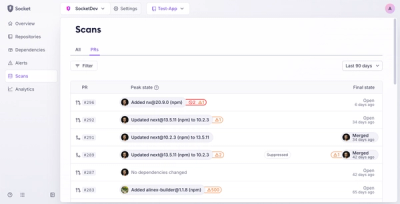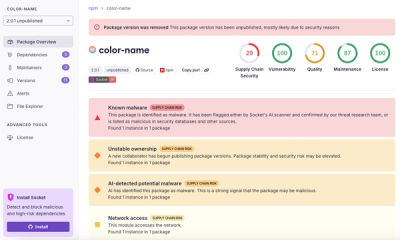
Security News
MCP Steering Committee Launches Official MCP Registry in Preview
The MCP Steering Committee has launched the official MCP Registry in preview, a central hub for discovering and publishing MCP servers.
postcss-nested-ancestors
Advanced tools
PostCSS plugin to reference any ancestor selector in nested CSS
PostCSS plugin to reference any parent ancestor selector in nested CSS.
When writing modular nested CSS, & current parent selector is often not enough.
PostCSS Nested ancestors introduces ^& selector which let you reference any parent ancestor selector with an easy and customizable interface.
This plugin should be used before a PostCSS rules unwrapper like postcss-nested.
See PostCSS docs for examples for your environment.
.level-1 {
| | .level-2 {
| | | .level-3 {
| | | | .level-4 {
| | | | |
| | | | --- & {} /* & = ".level-1 .level-2 .level-3 .level-4" */
| | | ------- ^& {} /* ^& = ".level-1 .level-2 .level-3" */
| | ----------- ^^& {} /* ^^& = ".level-1 .level-2" */
| --------------- ^^^& {} /* ^^^& = ".level-1" */
------------------- ^^^^& {} /* ^^^^& = "" */
}
}
}
}
/* Without postcss-nested-ancestors */
.MyComponent
&-part{}
&:hover {
> .MyComponent-part {} /* Must manually repeat ".MyComponent" for each child */
}
}
/* With postcss-nested-ancestors */
.MyComponent
&-part{}
&:hover {
> ^&-part {} /* Skip ":hover" inheritance here */
}
}
/* After postcss-nested-ancestors */
.MyComponent {
&-part{}
&:hover {
> .MyComponent-part {}
}
/* After postcss-nested */
.MyComponent {}
.MyComponent-part {}
.MyComponent:hover {}
.MyComponent:hover > .MyComponent-part {} /* No ":hover" inheritance here! */
Currently another plugin - postcss-current-selector - has tried to solve the problem of referencing ancestors selector. It works great, but its approach involves assigning ancestor selectors to special variables to be later processed by a further postcss plugin postcss-simple-vars.
PostCSS Nested ancestors instead replaces special ancestor selectors, makes no use of variable assignment and produces an output ready to be unwrapped with postcss-nested.
$ npm install --save-dev postcss postcss-nested-ancestors
postcss([require('postcss-nested-ancestors')]);
Type: string
Default: ^&
Ancestor selector pattern (utility option to automatically set both levelSymbol and parentSymbol)
Type: string
Default: ^
Define ancestor selector fragment relative to the matching nesting level
Type: string
Default: &
Ancestor selector base symbol
Type: boolean
Default: false
If this is true then this plugin will look through your declaration values for the placeholder symbol and replace them with specified selector.
An use case for this if enabling postcss-ref to work with dynamic @ref selectors. Read discussion here.
/* Before */
.foo {
&:last-child {
border-top: ref(^&, border-bottom);
}
}
/* After PostCSS Nested ancestors and PostCSS Nested */
.foo {
}
.foo:last-child {
border-top: ref(.foo, border-bottom);
}
This plugin currently fails when trying to replace more than one different ancestor placeholder in a single rule selector. This scenario has not been considered in order to not bloat the code with a remote use case.
More precisely, all ancestor placeholders are replaced, but processed as if they where the equal to the first ancestor placeholder found in selector.
In general, do not use more than one ancestor placeholder in a single rule selector. Anyway, this use case can be rewritten by splitting the selectors in multiple nested rules (see edge case 2).
/* 2 equal ancestor placeholders in single rule selector */
.a {
&:hover {
^&^&-b {
}
}
}
/* Output: It works but casts a warning */
.a {
&:hover {
.a.a-b {
}
}
}
/* 2 different ancestor placeholders in single rule selector */
.a {
&-b {
&:hover {
/* Will be processed as ^&^&-c{}, sorry! */
^&^^&-c {
}
}
}
}
/* Wrong output: All placeholder replaced with the value of the first one */
.a {
&-b {
&:hover {
/* Expected output: .a-b.a-c{}*/
.a-b.a-b-c {
}
}
}
}
/* This use case can be rewritten as: */
.a {
&-b {
&:hover {
^& {
&^^^&-c {
}
}
}
}
}
replaceDeclarations options used in a complex nesting scenario might have undesired outputs because of the different nature of CSS selectors and and declaration values.
In general, avoid replacing declaration values when inside a rule with multiple selectors (but why should you?). In other words don't get yourself into trouble!
Here is an example of what you don't want to do.
/* Don't replace declaration value inside multiple selector rules */
.a1,
.a2 {
&:hover {
&:before {
content: '^^&';
}
}
}
/* Output */
.a1,
.a2 {
&:hover {
&:before {
content: '.a1,.a2';
}
}
}
Contributions are super welcome, but please follow the conventions below if you want to do a pull request:
test.js) covering new features3.0.0
Breaking Changes
PostCSS 8FAQs
PostCSS plugin to reference any ancestor selector in nested CSS
We found that postcss-nested-ancestors demonstrated a not healthy version release cadence and project activity because the last version was released a year ago. It has 1 open source maintainer collaborating on the project.
Did you know?

Socket for GitHub automatically highlights issues in each pull request and monitors the health of all your open source dependencies. Discover the contents of your packages and block harmful activity before you install or update your dependencies.

Security News
The MCP Steering Committee has launched the official MCP Registry in preview, a central hub for discovering and publishing MCP servers.

Product
Socket’s new Pull Request Stories give security teams clear visibility into dependency risks and outcomes across scanned pull requests.

Research
/Security News
npm author Qix’s account was compromised, with malicious versions of popular packages like chalk-template, color-convert, and strip-ansi published.